As an Amazon Associate I earn from qualifying purchases.
Wiener schnitzel comes together quickly, and is deceptively simple, but like most such dishes, there is a secret knowledge about how to properly prepare it. Bad wiener schnitzel is cafeteria food, or worse.
At its best, however, this is one of life’s simple joys: The meat is tender and can be cut with a fork. The breading crispy, not greasy, and the squirt of lemon adds that zing the dish needs.
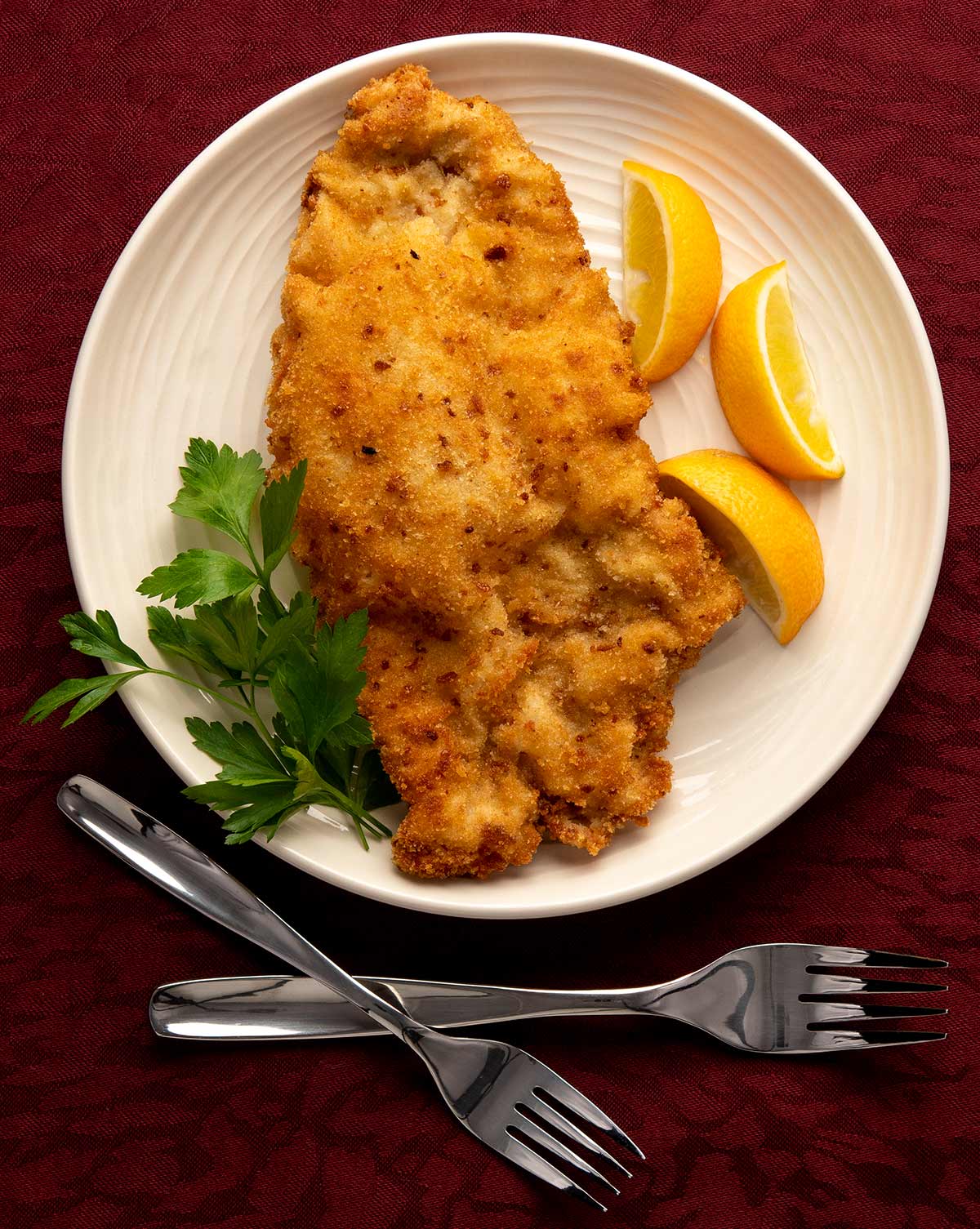
At its core, wiener schnitzel is just a breaded cutlet fried in fat and served simply with lemon, maybe a simple salad, cucumbers or potato salad. It is a blue collar lunch, a slightly more refined rendition of that Southern icon, chicken fried steak.
The trick is in the technique. The cutlet must be very thin, the flour light, the eggs beaten, the breadcrumbs applied with a light hand — and, most importantly, the schnitzel must swim in hot fat.
You read that right: not oil, fat. Lard is ideal, as is clarified butter, duck or goose fat. Wiener schnitzel is such a simple recipe that you really ought to use a flavorful fat or you will wonder what all the fuss is about.
That said, if you are violently opposed to using animal fats, go ahead and use sunflower or safflower oil. Not as good, but better than than not making wiener schnitzel. Oh, and one more thing: Regular butter doesn’t work well, either. The solids will burn before you’re done, making a dark, slightly bitter schnitzel.
Schnitzel? Cutlet? Scaloppini?
Yeah, they’re all the same. You could add “chicken fried chicken” if you’re in Oklahoma or Texas, too, or a milanesa if you are in Mexico. All are slabs of lean meat with little or no connective tissue, pounded very thin and either breaded or battered and fried.
Wiener schnitzel is, strictly speaking, made from veal. And it comes from Vienna, Austria.
So if you did not know, the name “wiener schnitzel” has nothing to do with hot dogs or wieners of any other kind. It’s named for the residents of Vienna. It’s actually been called the national dish of Austria, so the Austrians’ love for it goes beyond the capital.
It is very good with veal. But wiener schnitzel is equally good with a pounded white meat cutlet of any kind. Pounded pork cutlets are wonderful, too, as are breasts from partridges or cutlets sliced from wild turkey breasts. It is less successful with dark meats like duck, venison or beef. Still fine, but this dish is really a white meat thing.
If you are not a hunter, make it with veal first and foremost — there is plenty of humanely raised veal out there. Barring that, go for pork loin, then chicken, then turkey.
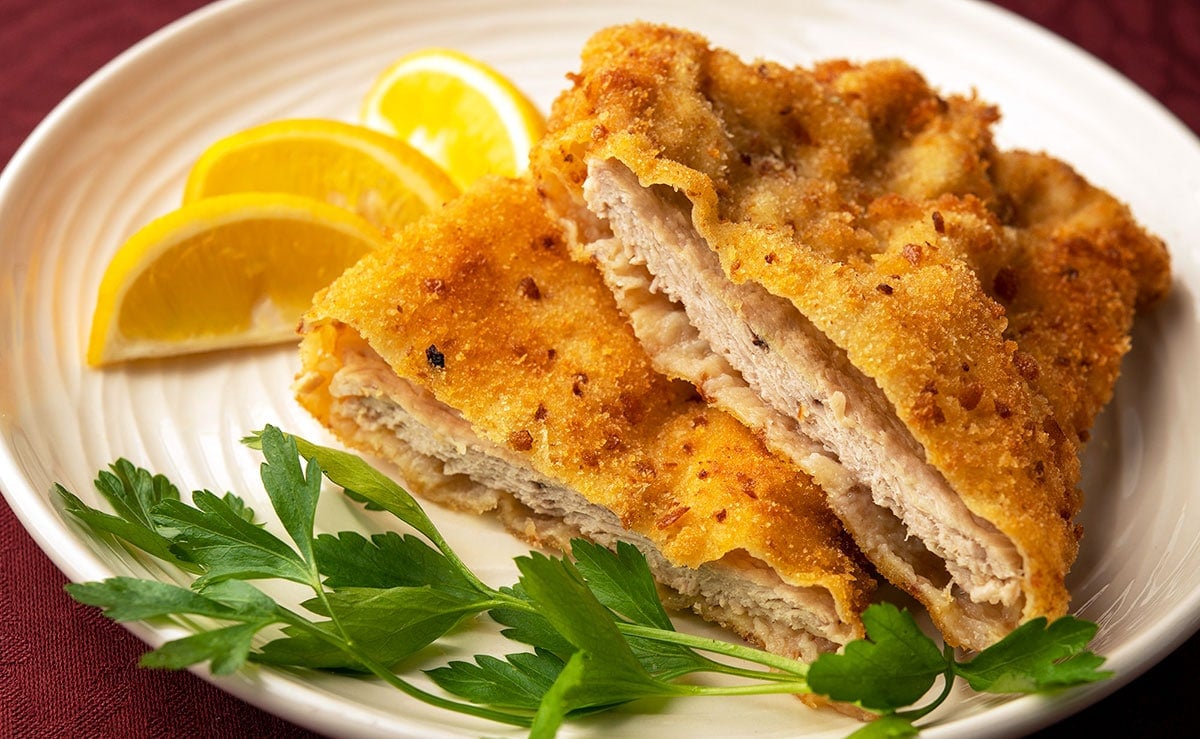
Tips for Better Wiener Schnitzel
This recipe is not rocket science. In fact, it’s one of the easiest, fastest, best recipes on the site. It’s a go-to whenever I have lots of pheasant or wild turkey or pork around. Just remember, let the schnitzel swim. Use the leftover fat the next morning for your eggs.
A few other tips:
- The cutlets need to be thin, thin, thin! I like to put pheasant or chicken breast, or a slice of turkey breast, or a slice of pork loin into a heavy freezer bag, then pound it thin with a rubber mallet, flipping the meat a couple times. Place your open palm over the cutlet and you’ll feel any thick spots. You can go as thin as 1/8 of an inch.
- Use fine breadcrumbs. Panko is terrible for wiener schnitzel. In fact, I will often toss regular breadcrumbs in the blender or food process to make them even finer. Why? To get the puff.
- Good wiener schnitzel has “the puff,” where the breading separates from the meat to form an ultra-crispy coating. This won’t work with coarse breadcrumbs, and it requires enough oil or fat for the cutlets to float. You also spoon hot fat over the exposed side of the schnitzel while the other side is frying, to set it.
- You want hot fat or oil, and this gets tricky because the smoke point of many animal fats is the 350°F you want to fry at. Keep an eye on things and you will be fine. Be sure to let the fat or oil heat back up again between cooking schnitzels.
Like this recipe? I’m betting you’ll also like my jaegerschnitzel recipe, Same idea, different sauce. And that one is great with red meat.
Wiener Schnitzel
Ingredients
- 4 to 8 veal or pork cutlets, or skinless chicken or pheasant breasts
- Salt
- 1 cup flour
- 3 eggs, lightly beaten
- 3 tablespoons milk
- 1 cup fine breadcrumbs
- Enough lard, clarified butter or duck fat to come 1/2 inch up the sides of your frying pan
Instructions
- Set out a work surface and place a slice of veal loin, pork loin, chicken breast or a slice of turkey breast in a freezer bag. Pound the meat out into a very thin cutlet, about 1/8 inch thick. Take your time, hitting the meat with about the same force as knocking on a door. Work from the center of the meat outward. If you are using pheasant or chicken, you will need to pound the thick end of the breast more than the thin end; pork or veal medallions should be evenly cut. Do one breast at a time.
- Preheat the oven to 200°F. Place a cooling rack over a baking sheet in the oven; this is for the schnitzels as they come out of the frying pan. Salt the cutlets well on both sides. Set up a breading station. Put the flour in a large tray, plate or shallow bowl. Do the same for the beaten eggs and milk, and then the breadcrumbs. Put the lard or clarified butter in the frying pan and turn the heat to medium-high. You want to fry at a temperature of about 325°F to 350°F.
- When the fat is ready, dredge a cutlet in flour, press it in well, then shake off the excess. Dredge it in egg-milk mixture, then the breadcrumbs. Do not press the breadcrumbs into the meat. Immediately put the breaded cutlet into the hot fat. Shake the pan a little to make sure the schnitzel does not stick to the bottom. The cutlet should float in the hot fat. Repeat quickly with as many cutlets as will fit in your pan, but don't crowd the pan.
- Fry the schnitzels until they are golden brown, about 2 minutes per side. As the first side is cooking, spoon hot fat over the other side. This will speed up the cooking process. Flip only once. When the schnitzels are done, put them in the oven on the baking sheet and repeat until you're done.
Video
Notes
Keys to Success
- The cutlets need to be thin. Take your time with this so you don't shred the meat. Place your open palm over the cutlet and you'll feel any thick spots.
- Use fine breadcrumbs. Panko is terrible for wiener schnitzel.
- Make sure the oil or fat returns to at least 325°F, and 350°F is better, before cooking more schnitzels. If the oil isn't hot enough, the schnitzels will be greasy.
- Leftover cutlets are amazing eaten cold, right out of the fridge, the next day. Great on sandwiches, too.
Nutrition
Nutrition information is automatically calculated, so should only be used as an approximation.
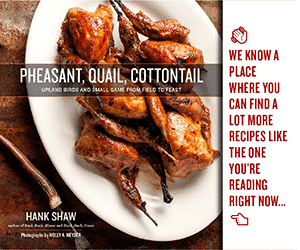
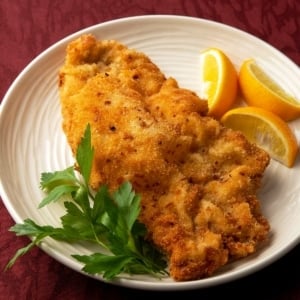
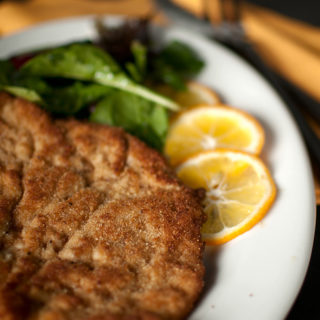




Enjoyed the recipe – love schnitzel from my time in Austria and Germany. (Love your site, too, btw!) But re: this: “Food arguments can get pretty heated, eh?” Try living in a family of Sicilian descent! Mamma Mia!
Anyway-that’s why my original post simply says ‘Schnitzel’, lol.
Ahhh- this is where the great family debate begins!
Uncle Klause stands firm that “A jaegerschnitzel is only the meat pounded thin and run through flour seasoned with salt and pepper and cooked IN a mushroom sauce”. Uncle Horscht disagrees. He is adamant that a “Jaegerschnitzel is cooked the same as a weinerschnitzel, with the sauce served on top!”
Since Horscht typically brings beer when he visits- I believe him.
I have to laugh- as I type this my male German shorthaired pointer is snoring behind me. Yes- his name is….’Schnitzel’.
Tom: Love that! Food arguments can get pretty heated, eh?
I make venison schnitzels all the time and they are delicious! It’s a great way to prepare the backstraps from an older animal. Slice the loin 1″ thick, pound it thin and prepare. In the winter we normally make homemade spaetzle with **gasp** a hunter sauce consisting of mushrooms and capers.
P.S.- the way our family has been taught is that the sauce normally accompanies the side served- in this case hunter gravy is a great accompaniment.
I also happen to take it on ‘authority’ that my schnitzels are every bit as tasty as those found in Germany. My mother-in-law is here this week and she IS German- moved here in the late 60’s. Plus I’ve fixed them for my German relatives (Uncle Horscht brings the beer, BTW) and they love it too. They don’t often eat venison so it’s a real treat for them!
Tom: LOL. Your “wiener schnitzels” with hunter sauce are really jaegerschnitzels, and equally awesome schnitzel.
the best recipe ever, eating it more than 35 years
This is delicious with a milk gravy. To make this, simply drain most of the lard from the pan leaving the breadcrumb and flour drippings. Add 1/2 cup cooking oil and 1/2 cup flour. Season with salt and pepper. Add several cups of milk and reduce. Continue to add more milk and reduce until it is the perfect consistency, and salt-and-pepper content. The gravy becomes sweet as you boil away water from the milk and reduce. Use this gravy just as you would attop chicken fried steak.
This is awesome! I lived in Austria for 2 years and can definitely say that Wienerschnitzel is one of my favorite dishes. I will try this recipe as it sounds very good. Never thought to look it up and make it myself. Nice read!
Great recipe and AWESOME history and lead-in–KUDOS!!!
One thing I noticed that is missing, and is what sets Austrian weiner schnitzel apart, and above German is cranberry sauce.
When I lived in Europe, I noticed this difference and was “educated” by an Austrian chef concerning this delicacy.
Austrian weiner schnitzel simply MUST be served with cranberry sauce on the side.
I’ve also found that fresh bread crumbs make a difference. Just blend pieces of bread in the blender. I like the texture much better than dried premade bread crumbs from the store…
Roadrunner – just to let you know that I’ve had schnitzel (pork variety) in Central Germany as well as Southern Germany with a whole bunch of different topping options offered. These include not only the popular mushroom cream sauce, (I wouldn’t call it “gravy” though) which is very good, but variations such as cranberries and brie and others I can’t recall right now. I’m not sure why you find it such an abomination! Though it’s true that schnitzel made with veal really doesn’t need anything more than the lemon, I find that the pork version isn’t as delicious on its own and benefits from the extra flavour of sauce. Thanks for this recipe by the way. I’m not sure I totally believe you that it can’t be made with oil though! I see a lot of recipes, also claiming to be authentic, that do not have your caveat about the need for animal fat in the frying medium. However, as I am a huge butter advocate, I’m happy to make it your way!
Just my two cents:
It isn’t difficult to make an edible Schnitzel, it is, however, pretty difficult to get a perfect result, so don’t give up if it doesn’t turn out as nicely as in the pictures. It will still taste pretty good.
It is absolutely crucial that you use enough fat, frying a Schnitzel is closer to deep frying (don’t use an actual deep frier, though) than to what you’d expect. While true that various kinds of fat will do the trick and there is some debate in Austria and Germany which is best, the general consensus is that some amount of butter is absolutely essential. Many people will use a mixture of lard and butter while others resort to pure clarified butter (thus avoiding burning the butter but a pretty pricy way of frying, reusing the fat is possible to some extent).
The essential part however is the temperature. If it’s too high, you’ll burn the crust, if it’s too low, the crust will be soggy and fatty. Splashing hot fat on the top side will cut down on the cooking time and make the crust nice and puffy – actually makes a difference in taste, not just the way it looks.
As to what to accompany the Schnitzel with: this is where you can easily get into a fight. A lemon wedge and some parsley are beyond dispute but many die hard purists will argue that anything past green salad is an abomination – although roasted potatoes or potatoe salad are pretty standard. Many Austrians will serve lingonberry (or cowberry – not to be confused with cranberries, completely different plant) jam on the side, giving the dish an interesting twist.
Many Austrians claim that Germans will often put some kind of gravy, often mushroom, on a Schnitzel – of course this is a complete and utter lie! Only a Northern German (about as far south as Franconia) would do something that horrible and as every good Southern German and Austrian knows, those people are the root of all evil and may not be let within a 100 yard radius of a kitchen and by law must be shot on sight ;). Or said more politely: don’t do it, it would be a waste of a perfectly good Schnitzel.
As far as the kind of meat to use: pheasant does sound interesting and you can probably use anything but I’d personally stick with veal – pork is about as far as I go and that is just a money issue.
Stephen: Well… fess up! What makes your oma’s schnitzel better than mine? Of course, it could just be that she made it – nothing quite like the flavor of family traditions.
Still not better than my oma’s wiener schnitzel. An original recipe from Germany I’d the best way to make it
I learned to prepare this dish from a German grandmother and, in later years, a more sophisticated version in Germany from a German Chef.
They are awesome to the taste buds and simple to prepare.
The more sophisticated version incorporates a teaspoon of lemon juice in the butter and adds fresh flat leaf parsley (Italian) to the breadcrumbs. What really make it great is the basting with the hot oil when you’ve turned it. Only one turn, please.
One sign of properly made Schnitzel is the breading should separate from the meat. It should remain intact, but sort of puff away. To make this happen, when you flip the Schnitzel you: spoon hot fat over the top; don’t flip them a second time; don’t stack the Schnitzel when you put them in the oven; and serve them with the first side up.
Now, if anybody can tell me why this is I’d appreciate it. My mother received vocational training to be a cook (Czechoslovakia, the part that used to be a part of Germany), and this was drilled into them when being taught the recipe for Wiener Schnitzel.
This recipe looks fine. But why is it in the duck and goose section when you say that it’s not really good for dark meats such as waterfowl? Just wondering. I’m carefully reading (and using) you duck and goose recipes in anticipation of your new book. The duck sliders were awesome (used skinny Montana late-season mallards).
Very good description on how to make a good Wiener Schnitzel.
Living in Germany, I have one fact to contribute (at least for German-speaking countries). In the restaurant business, a schnitzel made of any other meat than veal will always be called Schnitzel Wiener Art, meaning in the Viennese style. This is a legal issue. Most schnitzels in Germany are made with pork, a very good and less expensive cut.
I recently made schnitzel out of elk heart…brilliant! I pretty much think pounding meat down thinly and breading with a quick fry is always a winner. I love it very traditional with the lemons or with the jaeger sauce.
Very good recipe. It is just what we call milanesa around here in Mexico.
Very classy if done well, but not always turns out that way whey you ask for it in a resttaurant.
Already saw your jaeger schnitzel and milanese recipes. Just great!
Happy holidays!
Fantastic! I first had schnitzels in Argentina many years ago. They were called Milanesa and were served exactly as you have done here. I never would have thought to make them with a meat other than veal but, as usual, you have provided the inspiration! Thanks.